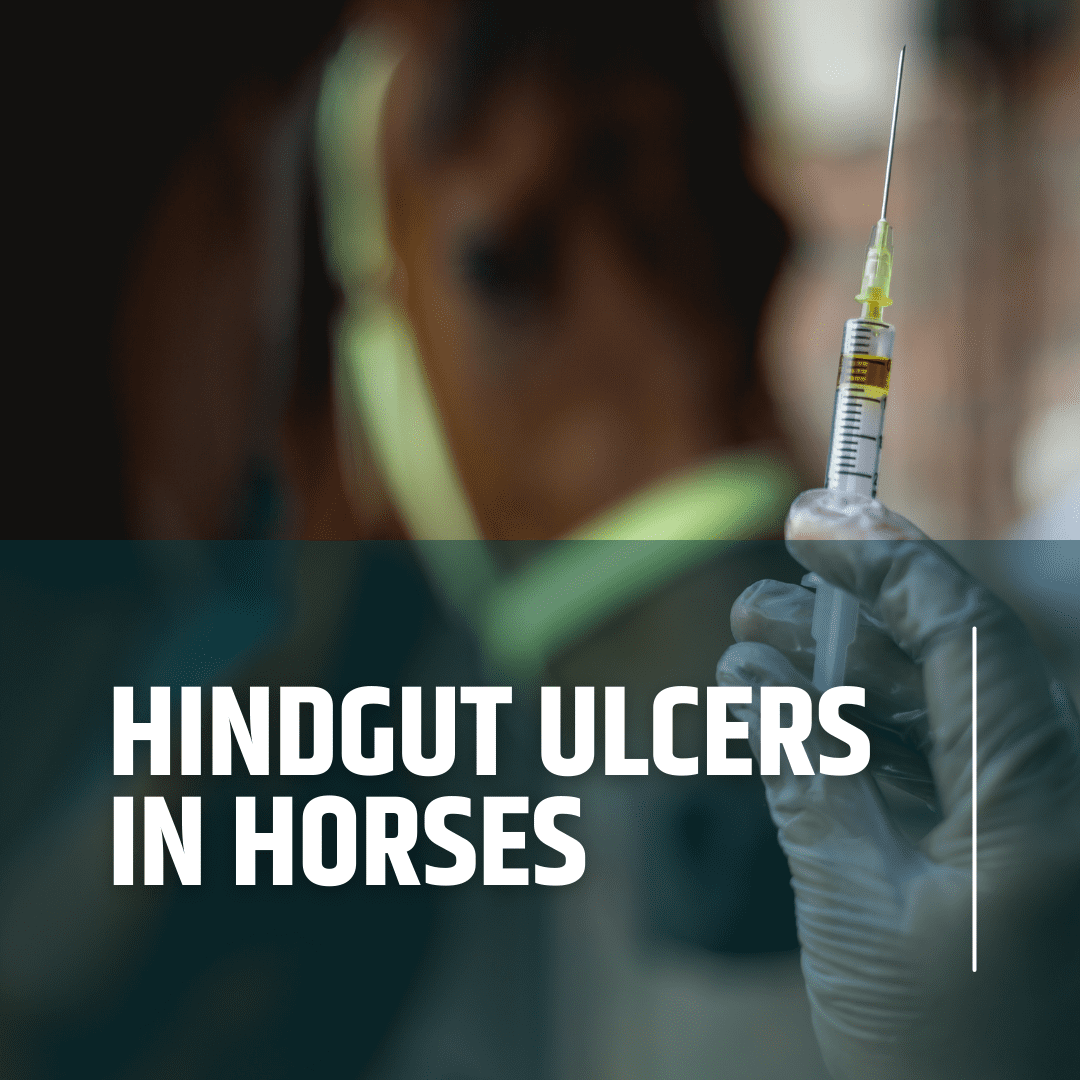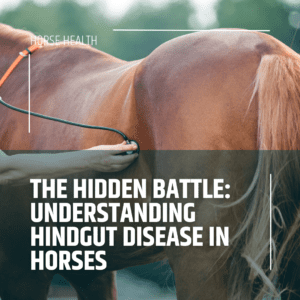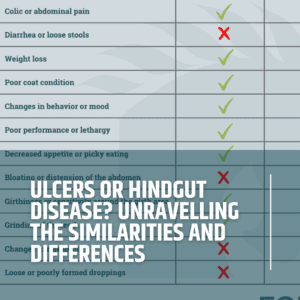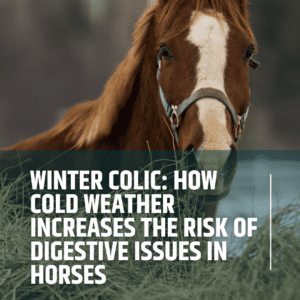

Ben Nedas
Chief Commercial Officer
Hindgut Ulcers in Horses
Originally published on January 16, 2024, this article explores the complex world of hindgut ulcers in horses, highlighting key diagnostic challenges and sharing how supportive options—such as EquiNectar—may help promote a more balanced digestive system.
01
Can you diagnose hindgut ulcers?
Diagnosing hindgut ulcers in horses presents unique challenges. Unlike gastric ulcers that can be identified using gastroscopy, hindgut ulcers are more elusive.
The hindgut's location and length make it inaccessible to standard scoping techniques. Additionally, current imaging technologies do not effectively reveal ulcers in this region. This diagnostic gap means that hindgut ulcers are a complex and often underdiagnosed condition in veterinary medicine.
Because the hindgut is located deeper within the horse's abdomen, it cannot be directly observed without invasive procedures that are rarely practical in clinical settings. In fact, colonoscopies in horses are particularly challenging because the lengthy evacuation necessary to prepare for the procedure can actually endanger the horse's life [4].
As a result, veterinarians must rely on indirect signs and symptoms to diagnose hindgut ulcers. These may include changes in behaviour such as increased irritability or aggression, decreased appetite, weight loss, poor performance, and changes in manure consistency [1]. Horses with hindgut ulcers may also exhibit signs of colic, including abdominal pain, pawing, rolling, or lying down more frequently.
The challenge is compounded by the fact that these signs and symptoms can be nonspecific and overlap significantly with other gastrointestinal issues, making it difficult for vets to pinpoint the exact cause [1]. Additionally, hindgut ulcers can vary in severity, with some horses showing mild symptoms while others experience more severe complications.
While vets may perform thorough physical examinations, including abdominal palpation, and conduct blood tests to assess for changes in blood cell counts or electrolyte imbalances, these tests alone are not definitive and may only provide supportive evidence. Fecal occult blood tests have been investigated as a diagnostic tool, but research has shown they have high specificity yet fairly low sensitivity, resulting in several false negatives [4]. A positive test strongly suggests the presence of ulceration, but a negative test does not rule out colonic ulcers.
More advanced diagnostic procedures, such as specialised endoscopy or ultrasound to visualise the hindgut, can be invasive and require specialised equipment and expertise that may not be readily available. Due to these diagnostic challenges, hindgut ulcers are frequently underdiagnosed or misdiagnosed, which can lead to delayed treatment and potentially worsen the horse's condition. This underscores the critical importance of horse owners and veterinarians being aware of the signs and symptoms associated with hindgut ulcers and considering them as a potential cause when evaluating a horse's health and performance [1].
02
How common are hindgut ulcers?
The prevalence of hindgut ulcers in horses is more widespread than many horse owners realise. In a landmark necroscopic study by Pellegrini, over 500 horses from a Texas abattoir were examined for the presence of both gastric and colonic ulceration [4]. The study encompassed horses from a variety of sources and made a notable distinction between general horse populations and performance horses.
The findings revealed a stark contrast in prevalence rates:
Mixed Population (First Group): Among 365 horses of mixed breed and function—including riding, range, race, and show horses—55% were found to have gastric ulcers, while 44% exhibited colonic ulcers [4]. Even in this presumably lower-stress group that included many range horses thought to be less stressed and largely ulcer-free, the incidence of colonic ulceration was remarkably high.
Performance Horses (Second Group): Among 180 race, show, and other performance horses, the results were even more alarming. A staggering 87% were shown to have gastric ulcers, while 63% exhibited colonic ulcers [4]. The study demonstrated that almost all performance horses have some kind of ulcer, with at least 60% suffering from colonic ulcers specifically.
These statistics highlight the substantial impact of activity level, stress, and lifestyle on equine gastrointestinal health [1, 4]. The elevated rate of hindgut ulcers in performance horses underscores the stress and dietary challenges these animals often face, including high-carbohydrate diets that can disrupt the delicate balance of the hindgut microbiome. This contrast also emphasises the importance of tailored management and preventive strategies for different categories of horses, ensuring their wellbeing and longevity.
The high prevalence of subclinical anemia in horses and the fact that colic remains the number one killer of horses underscore the critical need to better understand both gastric and colonic ulcers with an eye toward prevention and treatment [4].
03
Hindgut Acidosis: A Related Condition
Hindgut acidosis is relatively common among horses, particularly those on high-grain, low-forage diets. However, it's crucial to realise that rich grass is also a likely cause—a factor that affects leisure horses as significantly as performance horses.
This condition can occur with or without hindgut ulcers and is characterised by a decrease in the pH of the hindgut. Research has shown that grazing horses typically have a faecal pH in the range of 6.4 to 6.7, whilst a pH between 6.0 and 6.4 is characteristic of subclinical acidosis. pH values below 6.0 are associated with osmotic diarrhoea and indicate severe acidosis in the hindgut [2].
Modern stabled horses often consume high-grain diets designed to provide energy for performance. The stomach of an adult horse can hold only 3 to 5 litres of food, and unlike traditional grazing horses whose stomachs are always partially filled and buffered with fibrous foods like grass and hay, stabled performance horses may experience rapid fluctuations in stomach contents [4]. When large amounts of grain are consumed, undigested starches can pass into the hindgut, where they are rapidly fermented by bacteria.
The problem is particularly acute in performance horses on high-carbohydrate diets. These diets frequently exacerbate gut health issues, leading to a proliferation of lactic acid-producing bacteria with a decrease in short chain fatty acids (SCFAs), which are a major component of equine nutrition [2]. The increases in lactic and acetic acids cause a pH drop in the horse's hindgut, potentially leading to acidosis, weight loss, decreased appetite, diminishing condition (muscle tone deterioration), demeanour changes, and loss of performance consistency.
Interestingly, the management and treatment of hindgut acidosis remain largely consistent regardless of the presence of ulcers. The focus is typically on restoring and maintaining a balanced gut environment through dietary management and microbiome optimisation.
04
Signs of hindgut acidosis
The health of a horse's hindgut is intricately linked to various observable factors, with faecal pH and consistency being primary indicators [2]. A low faecal pH and alterations in droppings' consistency often suggest hindgut acidosis, potentially stemming from an imbalanced gut microbiome. However, these are not the only signs to watch for. Hindgut acidosis can manifest in several other ways, particularly affecting a horse's temperament and movement.
Temperament Changes: Horses suffering from hindgut acidosis may exhibit noticeable changes in temperament. This could range from increased irritability and anxiety to a general decrease in responsiveness. Such behavioural shifts are often a horse's way of communicating discomfort or distress caused by digestive issues [1].
Discomfort During Movement: Physical signs, particularly those related to movement, can also be indicative of hindgut issues. Horses might show signs of discomfort or reluctance during exercise, especially when engaging in activities that typically involve flexing or turning. This discomfort can stem from pain or irritation in the hindgut area, exacerbated by physical activity.
Overall Health Indicators: It's also important to consider overall health indicators such as changes in appetite, weight loss, or a general decline in condition. Subclinical anemia has been noted as having a high prevalence in horses with ulceration [4]. These signs, coupled with altered faecal characteristics and temperament changes, provide a more comprehensive picture of a horse's hindgut health [1].
Observing these various aspects can guide horse owners and vets towards a more accurate assessment of hindgut health and the potential presence of hindgut acidosis. Prompt recognition and intervention are key to managing these conditions effectively, ensuring the wellbeing of the horse.
Learn more about the role of the hindgut and its significance to equine digestion.
05
Treatment Approaches
The treatment of hindgut ulcers and acidosis primarily revolves around dietary adjustments and supportive care. This includes increasing forage intake, reducing grains, and providing a stress-free environment. In some cases, vets may prescribe medications to support gut health and alleviate symptoms.
The goal is to restore the natural pH balance of the hindgut and support a healthy microbiome. This often requires a multifaceted approach that addresses both the symptoms and the underlying causes of hindgut dysfunction. Given that modern stabled horses face unique challenges compared to horses maintained on pasture, management strategies must account for these differences [4].
06
Prevention: focusing on the gut microbiome
Preventing hindgut issues is largely centred around optimising the gut microbiome. This involves feeding practices that promote a healthy balance of microflora in the hindgut. The key is to mimic, as much as possible, the natural grazing conditions that horses evolved for—where the stomach contents are always partially filled and buffered with fibrous foods like grass and hay, and moderate levels of exercise keep those contents safely in the mucus-covered glandular portion of the stomach [4].
High-forage diets, regular feeding schedules, and minimising stress are key strategies in maintaining a healthy gut environment. If forage choices are contributing to the problems, changing the forage source may be necessary. The gut microbiome plays a crucial role in equine health, directly influencing overall wellbeing and performance [2, 3]. A balanced microbiome supports proper digestion, nutrient absorption, and immune function whilst helping to maintain the appropriate pH levels in the hindgut.
07
The Role of Supplements

Understanding the different types of supplements available and their effectiveness is crucial for making informed decisions about your horse's digestive health.
- Probiotics: The effectiveness of probiotics in managing hindgut acidosis remains a topic of ongoing debate. Whilst adding beneficial bacteria to the horse's gut may help in theory, scientific evidence supporting their clinical efficacy in horses is limited and conflicting [3]. Research suggests that the quality control of commercial probiotic products can be poor, and information on bacterial species content and the number of live organisms is often inaccurate in over-the-counter products.
- Prebiotics: Similarly, prebiotics—which are designed to feed beneficial bacteria in the gut—have shown mixed results. Research has revealed that whilst prebiotics may increase bacterial diversity, they can also have unintended consequences. Some studies have shown that prebiotic supplementation can reduce beneficial bacteria families like Lachnospiraceae, which produce butyrate and support intestinal health [3]. In some cases, prebiotics might even exacerbate gastric issues instead of alleviating them, particularly when they alter bacterial populations in the foregut.
- EquiNectar: EquiNectar stands out as an effective digestive supplement for horses. It optimises the gut microbiome. It contains digestive enzymes that work in the small intestine, reducing undigested starch and fructans from reaching the hindgut. This action not only balances but also optimises the hindgut microbiome, reducing the number of lactate-producing bacteria. Research has shown that horses fed enzyme-supplemented diets have greater nutrient intake and increased total nutrient digestibility compared with control diets. Studies have also demonstrated lower faecal coliform counts in horses fed diets supplemented with cellulase and xylanase, indicating improved gut health [3].
08
EquiNectar: A Science-Backed Solution

EquiNectar stands out as an effective digestive supplement that takes a unique approach to optimising the gut microbiome. Rather than attempting to add bacteria (probiotics) or feed existing bacteria (prebiotics), EquiNectar provides a comprehensive blend of digestive enzymes that work in the small intestine to reduce the digestive burden on the hindgut.
The Active Enzymes in EquiNectar:
The enzyme-rich malt extract in EquiNectar includes naturally occurring enzymes that work synergistically to support digestion:
- Amylase (both alpha and beta forms) helps break down starch—particularly important since horses naturally produce very little amylase and modern high-grain diets place significant demands on starch digestion [4]
- Fructanase breaks down fructans, the complex sugars found in fresh grass that can trigger hindgut issues when they reach the large intestine undigested
- Phytase breaks down phytic acid, improving the availability of essential minerals like phosphorus and calcium
- Cellulase, Xylanase, and Beta-glucanase work together to break down complex sugars in plant cell walls, aiding forage digestion and supporting the natural buffering capacity of fibrous feeds
Scientific Evidence:
A comprehensive study with 72 Thoroughbred racehorses demonstrated the effectiveness of EquiNectar in supporting hindgut health. The research showed that faecal pH rose from an average of 6.20 to 6.40 over just four weeks of supplementation—a statistically significant increase (p<0.0001) [2].
Most importantly, the proportion of horses with a "normal" faecal pH increased dramatically from just 11% at the study's outset to 55% at its conclusion [2]. This meant that although their standard concentrated diet was unchanged, many horses developed a faecal pH comparable with that of grazing animals over a relatively short period of supplementation—effectively helping to restore the buffered gut environment that horses evolved to maintain [4].
By aiding in the breakdown of feed in the foregut, EquiNectar helps reduce the starch load reaching the large intestine. This is particularly significant for managing hindgut acidosis, where rapid fermentation of starches and sugars can create an unhealthy pH balance and proliferation of lactic acid-producing bacteria [2]. Given that 63% of performance horses have been shown to suffer from colonic ulcers [4], supporting optimal digestion before feed reaches the hindgut is a critical preventive strategy.
09
Feeding Recommendations
When hindgut acidosis or colonic ulceration is suspected, dietary management is crucial. The focus should be on:
- Increasing forage intake to ensure a fibre-rich diet that mimics natural grazing conditions
- Assessing pasture, hay, and haylage to determine if there are problematic grass varieties or if fructan levels are too high
- Limiting grain and concentrates that can ferment in the hindgut—particularly important given the limited stomach capacity of horses [4]
- Providing small, frequent meals to maintain a stable gut environment and keep the stomach partially filled, as would occur naturally during grazing [4]
- Ensuring access to clean, fresh water at all times
Diet plays a pivotal role in maintaining hindgut health, and these feeding practices are fundamental in both treatment and prevention of hindgut acidosis and colonic ulceration.
09
Is EquiNectar Right for Your Horse?
In the context of hindgut ulcers and acidosis, EquiNectar can be a valuable addition to your horse's diet—particularly important when considering that 44% of horses across all populations and 63% of performance horses suffer from colonic ulcers [4].
By providing essential digestive enzymes, EquiNectar aids in more efficient digestion in the small intestine, reducing the risk of undigested starches and fructans fermenting in the hindgut. This approach addresses one of the root causes of hindgut dysfunction in modern stabled horses consuming high-grain diets.
EquiNectar's role in rebalancing and optimising the gut microbiome—backed by scientific research showing significant improvements in faecal pH [2]—contributes to overall gut health. The supplement also contains all B vitamins, notably high in folate and niacin, which support overall health and wellbeing.
Horse owners have reported numerous improvements when using EquiNectar, including improved dropping consistency, reduction in agitation and irritability, enhanced performance, better appetite, improved body condition, and more positive demeanour and behaviour—all benefits that align with addressing the symptoms associated with both gastric ulcers and hindgut diseases [1].
Given the high prevalence of colonic ulceration across all horse populations—and especially in performance horses—proactive digestive support through enzyme supplementation represents a science-based approach to promoting hindgut health and preventing the serious complications associated with colonic ulcers and acidosis.
References
- Nedas, B. (2024). "Hindgut Ulcers in Horses." EquiNectar. https://equinectar.com/hindgut-ulcers-in-horses/
- Waring, R. (2024). "Vet Times – EquiNectar – Volume 54." EquiNectar. https://equinectar.com/vet-times-equinectar-volume-54/
- Nedas, B. (2023). "Supporting a horse's gut microbiome with supplements: which option is right for your horse?" EquiNectar. https://equinectar.com/supporting-horses-gut-microbiome-with-supplements/
- Pellegrini, F.L. (2005). "Results of a large-scale necroscopic study of equine colonic ulcers." Journal of Equine Veterinary Science, 25(3), 113-117. https://doi.org/10.1016/j.jevs.2005.02.008
ABOUT EQUINECTAR
Description
EquiNectar® is a natural feed supplement, that is scientifically proven to:
- Re-balance your horse’s gut bacteria
- Help your horse maximise benefits from its feed
- Improve your horse’s condition
More information
EquiNectar® is produced by Tharos Ltd in the UK. It is a natural source of digestive enzymes and contains only the following ingredients:
- Our patented enzyme rich malt extract
- Medium chain triglycerides (from coconut oil)
- Potassium sorbate
For more details of the enzymes within EquiNectar® take a look at the ingredients and enzymes page.
How to feed
Simply add EquiNectar® to your horse's daily feed, using the Feeding Rate chart to determine the correct amount.
For detailed instructions about how to introduce EquiNectar, please read the comprehensive Feeding Guide page.





